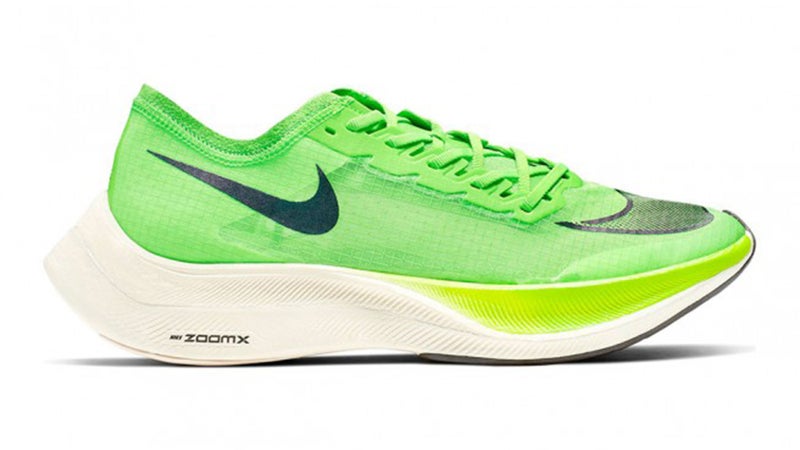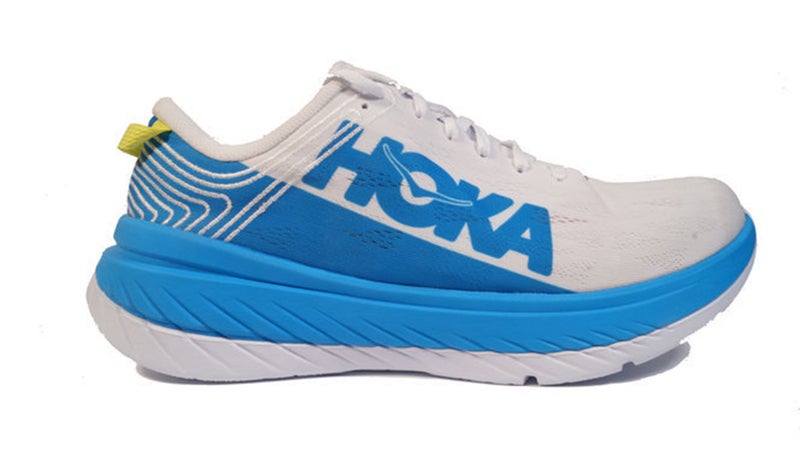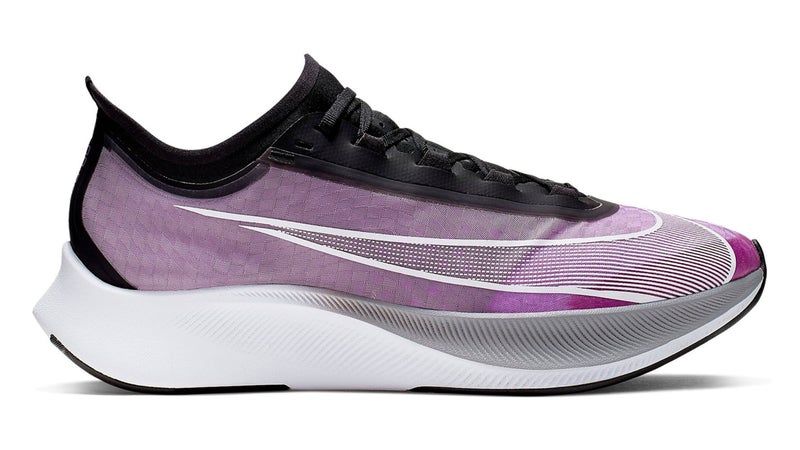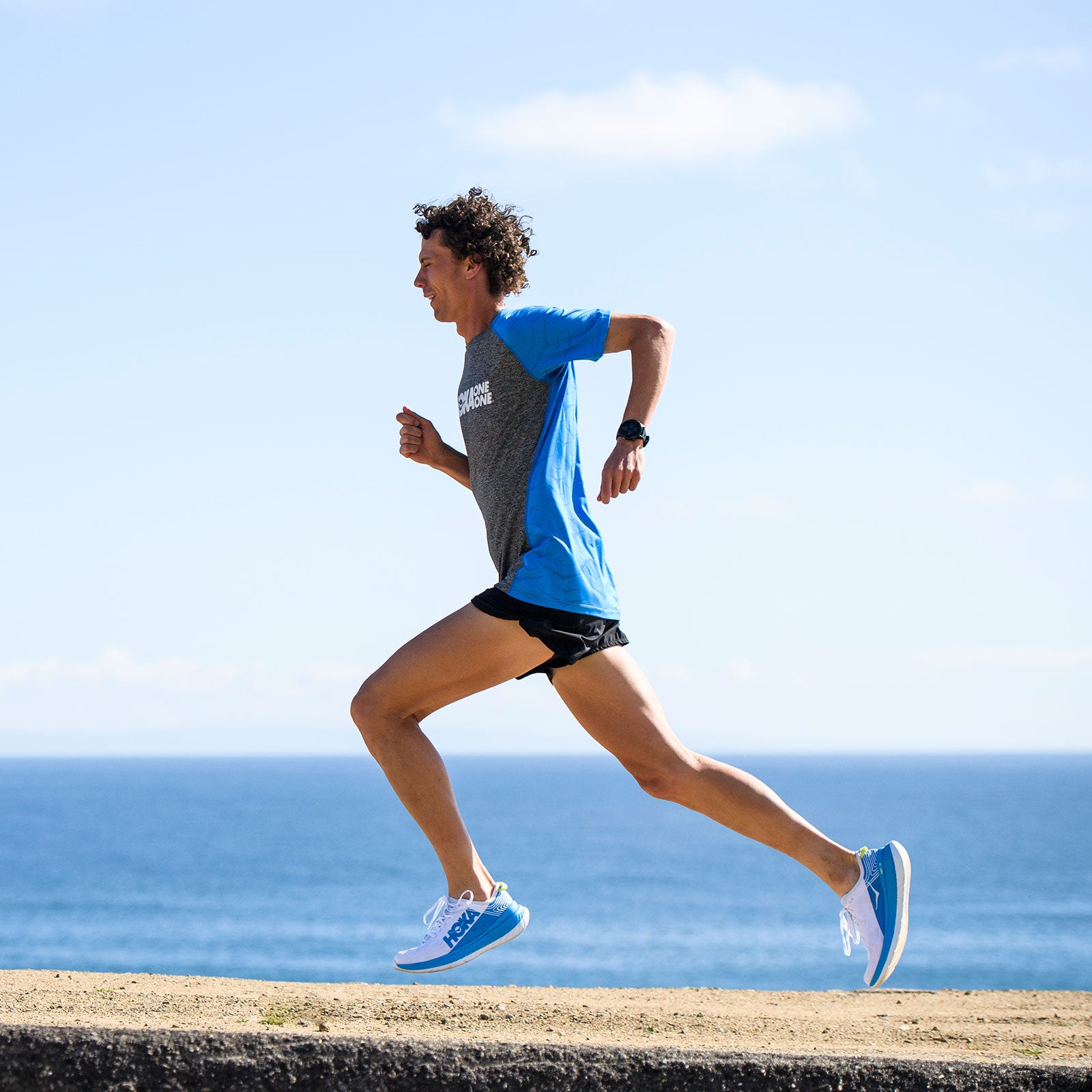In 2017, Nike released the Vaporfly 4%, a racing shoe engineered to dramatically improve running economy and help the world’s fastest marathoners test . (At $250, the 4% would also test the limits of what a rational person might be willing to shell out for a pair of mass-market sneakers.)��Unlike��typical racing flats,��the Vaporfly��was lavishly cushioned with a proprietary ultralight foam dubbed ZoomX, to keep shoe��weight down to 6.8 ounces.
But the foam was only half the story. The Vaporfly’s��midsole also included a spatula-shaped carbon-fiber plate that the brand said was��meant to help fling the runner forward with every stride—or to at least create a convincing illusion that something like that was happening. “I feel like I’m running downhill,” Nike-sponsored marathoner Galen Rupp purportedly said the first time he tried it.
Ever since Nike launched the first Vaporfly, which has��since��been updated twice, there have been debates about whether the shoe—specifically the carbon-plated midsole—should be allowed in competition, with about “spring-loaded” soles and “technical doping.” Research seems to indicate that the foam contributes a greater boost in running economy than the carbon plate. But that is partially because there is not yet a clear consensus on how the plate is supposed to work. Nike just released a small study to help shed some light on the issue, though it��left open the question of whether the foam was providing the lion’s share of the advantage.��
For now��the carbon plate remains street legal. (As far as I’m concerned, if Eliud Kipchoge can set an IAAF-ratified world record in a plate-abetted shoe, the rest of us shouldn’t have too many qualms about getting in on the action.)��What’s more, the 4% is not the only running shoe to include it. Nike has given another shoe model the same piece of hardware that had 4% wearers giddily “running downhill,” and Hoka has come out with its own version. I decided to compare these three models to see what all the fuss was about.��
The Shoes
Nike ZoomX Vaporfly Next%

Heel Height: 32 millimeters��
Forefoot Height: 24 millimeters
Drop: 8 millimeters
Weight: 6.8 ounces
Price: $250
The latest supercar to peel off the Nike assembly line, with 15 percent more ZoomX foam than its 4% predecessor, the Next% is intended for racing distances from the 5K to the marathon. Runners who liked the 4%��but were dismayed with the shoe’s inability to grip the road on wet days will be happy to learn that Nike has added a tread pattern and deep grooves similar to what was .
Hoka One One Carbon X��

Heel Height: 32 millimeters
Forefoot Height: 27 millimeters
Drop: 5 millimeters
Weight: 8.7 ounces
Price: $180
For its most hyped go-fast shoe to date, Hoka also developed a new, lightweight foam called ProFly X. (What is it with all these X’s?) The company, which was ahead of its competitors in the max-cushioning game, has paired the ProFly foam with a carbon plate to bolster the pronounced rocker the brand is known for. While Nike’s plate looks like something you can flip eggs with, the Hoka , supposedly to optimize supination and help you push off your big toe.��
Nike Zoom Fly 3

Heel Height: 32 millimeters
Forefoot Height: 22 millimeters
Drop: 10 millimeters
Weight: 9.9 ounces
Price: $160
In several ways, Nike’s Zoom Fly 3 resembles the Next%. Like its more ostentatious sibling in the 2019 ,��the Zoom Fly 3 fuses a light, semitranslucent upper with a plush midsole. (Both shoes incorporate the same carbon plate.) Unlike the Next%, however, the Zoom Fly 3 is made with Nike’s React foam��instead of the ZoomX, making the shoe heavier��but significantly more durable. The Zoom Fly 3 also has a sock liner for additional comfort.��
The Tests
The last time I did a comparative shoe test, I took each model for two different kinds of easy runs and one quicker-tempo session. Since all three shoes in this test are designed for running fast, I decided to place a greater emphasis on speed. These shoes also all have considerable stack height, so I wanted to see how they would handle running around corners and tighter turns.
Eight Miles Easy��
Eight miles is my standard��run. Since many shoe deficiencies only make themselves known after an hour of so of continuous running, I wanted to make sure to try��each model on an easy run over undulating terrain, when I wouldn’t necessarily be running as high up on my toes as I might be at a faster pace. I ran these runs at a pace between seven and eight minutes per mile.��
Winner: Carbon X
Not everyone is going to feel this way, but especially on easy runs, I prefer a shoe that I don’t notice while I’m wearing it. The Zoom Fly 3’s firmer outsole rubber made me feel like I was running on a pair oversized erasers, whereas the Next% is probably the most conspicuously squishy running shoe I have ever worn. (���ϳԹ���’s Alex Hutchinson��once suggested that, were it not for the carbon plate, running in the 4% would be like running on marshmallows.)��
The Carbon X is stiffer underfoot than the Next% and has a relatively low heel-to-forefoot drop, but it still provides a massive amount of cushioning, so you never feel like you’re hammering the pavement. For me, the Carbon X felt most smooth when running eight miles at cruise-control pace. Most likely, this is because eight miles easy is a distance and tempo at which I’m still comfortable enough that my form never devolves into a heel-striking mess��the way it inevitably does in the latter stages of a marathon.
Fast 800’s��
What better place to assess a shoe’s ability to run turns at speed than on a standard 400-meter track? In order to get a sense of what these shoes felt like at a pace that (in my lost youth) I might have been able to sustain for a 5K, I went to my local track and banged out a few 800’s��at a five-minute-per-mile pace.��
Winner: Next%
This one came as something of a surprise, to be honest. While there has been the previous iteration of Nike’s vaunted shoe provides a performance benefit in the marathon, I would have assumed that the Next% wouldn’t be responsive enough for supershort, fast stuff. There’s a reason, after all, why track spikes have remained largely () unaffected by the recent surge in max cushioning.��
And yet��the Next% proved to be supremely effective at a five-minute-mile pace. Part of this is surely because this shoe is the lightest in this test. But I was also palpably aware of its forefoot cushioning, which is three millimeters more than the 4%. I don’t know whether it was the carbon plate or that extra padding, but I definitely experienced a propulsive sensation when I was running at speed and pushing off my toes. The other two shoes felt a little clunkier��at this pace��and didn’t provide as much pop with the toe-off.��
Two Miles Steady��
I also��tested each of these shoes over a flat, two-mile loop at my (aspirational) marathon pace: roughly 5:50 per mile. (For both this test and the track test, I was very conscious about not running it like a workout. I gave myself a long recovery so that I could focus on the shoes and not on the fact that I’m kind of out of shape.)
Winner: Next%
Yes, it is perversely expensive, but as far as I’m concerned, the Next% is the best long-distance racer on the market. Though wobbly when you’re just puttering about, they let you get into a groove and maintain it once you start rolling at marathon-pace tempo.��
If you spring for these shoes, I recommend breaking them in with a few easy runs and otherwise just saving them for race day. In my experience, the Vaporfly��showed signs of wear on the sole after just one run. In the Next%,��Nike has wisely added some rubber paneling to mitigate the problem, but they still feel pretty fragile.��
This isn’t to say that the Next% is going to suit everyone. Runners with wider feet may prefer the Carbon X, which also felt very smooth, if a little heavy, at just under my 5:50 pace. (And no wonder: that was roughly the tempo Jim Walmsley maintained for 50 miles to break the world record in a launch event for the shoe.) While the Carbon X isn’t optimal for up-on-your-toes-style short-distance running, I found its gentle rocking-chair effect most pronounced during the two-mile test, because I was consistently running off my midfoot. That said, if I were to run a longer distance at that pace, I would undoubtedly start coming down harder on my heel. At that point, the more aggressively propulsive ZoomX foam (and the larger offset ratio of the Next%) becomes an invaluable asset.��
Takeaways
If you’re a hardcore heel striker, the Nike models will probably work better for you than the Carbon X. If you’re a mid- or forefoot striker who prefers a cushioning system that doesn’t call attention to itself, the Hoka may be more to your liking.��
As for whether a proliferation of ever more aggressive carbon fiber plates is going to revolutionize distance running, I won’t hold my��breath. The technology seems to be catching on:��in September, New Balance is releasing a designed specifically for the road mile. But the jury is still out on how effective that��plate is. I think lighter, more propulsive foams are still the bigger story.


